Happy Easter everyone! It’s a day for feasting and celebration, and so we’ll offer a complete meal that is easy to make but delicious.
But first, some music to enjoy while cooking. Bach’s “St Matthew Passion”:
Roast Beef
Get a suitable large cut of beef. Fattier is better; prime rib is the fattiest, but here we used a 4-5 pound (2-2.3 kg) sirloin.
Because beef is not fatty enough for us, we made a glaze from butter and Italian seasonings. Melt a stick (8 tbsp) of butter and combine it with 2 tbsp dried herbs and salt and pepper to taste.
Spread the glaze on the beef until all sides are covered. Then, place the beef in a ceramic pot, fatty side up, on a bed of either fibrous vegetables (such as celery and carrots) or wooden sticks to elevate it:
We elevate the beef because we’re going to add water to the pot to keep the drippings from burning. At the end, we’ll re-use the drippings to make a sauce. If we didn’t elevate the beef, the bottom part of the roast would be boiled rather than roasted.
Preheat the oven to 400 F (200 C), and put the beef in the oven with a layer of water in the bottom of the pot. After ten minutes reduce the heat to 300 F (150 C) and cook for 20 minutes per pound if you like medium rare beef and 23 to 25 minutes per pound if you like medium beef.
It will come out looking something like this:
Move the roast to a serving plate:
Cut some vegetables for the sauce. We used tomatoes, garlic, onion, and scallion:
Add the garlic, onion, scallion to the drippings and stir fry them on the stove for 5 minutes:
Then add the tomatoes and cook just a bit longer:
This sauce is ready to be spread over the beef.
Baked Potatoes and Roast Beets
We had space in the oven so we cooked potatoes and beets along with the beef.
The potatoes were wrapped in aluminum foil and baked individually:
The beets take a bit more preparation. We peel and dice them before cooking.
Peel the beets just as you would a potato or carrot, removing the skin. Once the skin is removed, the beet flesh will stain your hands; so we put a sheet of plastic wrap between our hand the beet during peeling.
Then dice the beets and put them in a ceramic pot for roasting:
Beets deserve a sauce, just like the beef. Ours used olive oil, garlic, butter, lemon juice, balsamic vinegar, and dried herbs:
Mix the sauce ingredients apart from the butter in a mixing bowl, then add the butter and sauce to the beets:
Cover the beets in aluminum foil and put them in the oven at 300 F (150 C) along with the beef and potatoes. At this oven temperature the beets and potatoes need about 30 to 45 minutes to cook.
When the beets are done they look like this:
Conclusion
The complete meal looks like this:
Roast beef, baked potato with sour cream, and roast beets. Plus an abundance of leftovers!
We wish you a joyful and blessed Easter!







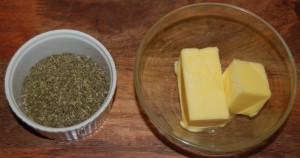
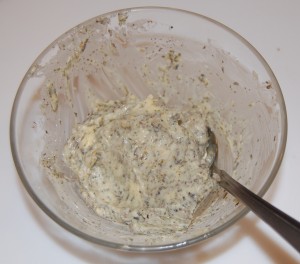

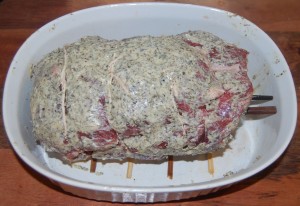
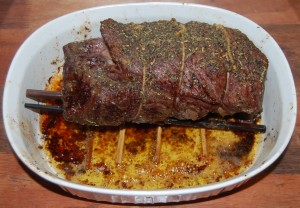
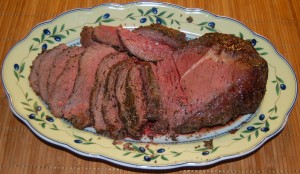
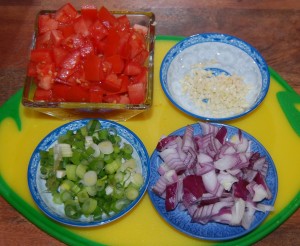
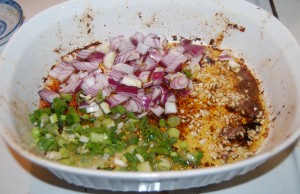
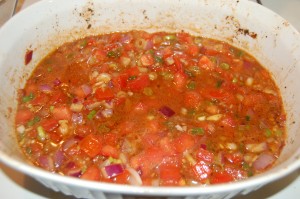

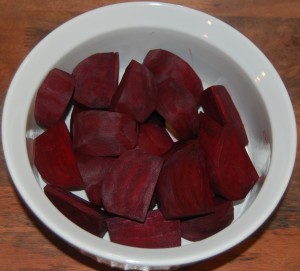
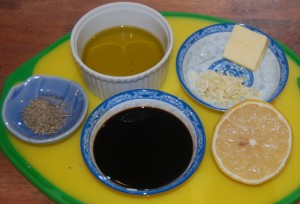
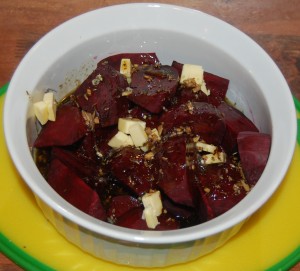
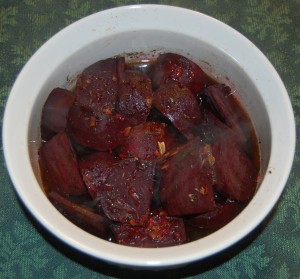
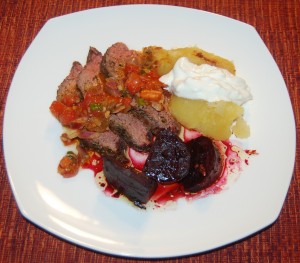




I love beets. Those look so good. Wonder if I have any in the freezer. . . .? The sauce for the roast looks good, too. I’ll have to remember that. Thanks.
YUM! Sounds like a lovely celebration meal.
Something I have been doing with beets for a while is to wrap them all in one big foil package and bake at 375 for an hour or more, depending on how big the beets are. When done I let them cool in the foil, then peel them. The peel comes off very easily that way, so it seems like less of a mess to me and I think roasting them in the skin concentrates the flavor. When the beets are from our garden, I don’t wash them, just brush off the dirt and snip off the leaves, but leave the crown intact and the root end. That helps keep that good earthy flavor in, I think.
This can all be done in advance and the peeled, sliced beets kept refrigerated for a day or two till ready to be warmed up with a sauce. Or I toss them with a vinaigrette right away and then chill. (Blue cheese is a good addition to the salad version)
Oh, yum! I love the recipe for roast beef–that sounds like a good one. I have a bunch of bison roasts in the freezer to try this out on! 🙂
Yes, Ellen, I do the same, but I wash mine and boil them for about the same length of time, then cool them in cold water. The skins just slip right off. I then slice them, take handfuls and put them in double ziplock bags, and toss them in the freezer. When I want beets, I put a big lump of butter in a small pan, put in the frozen beets, and thaw them on a low setting until they are hot and ready to eat.
Fantastic. The yumminess from the pictures comes through… and I love the amount of butter you must have !!!
Happy Easter! That looks absolutely mouth-watering! I really have to take advantage of these recipes rather than just cooking eggs or ribeye every night. (not that those don’t taste good).
I’ve heard it is not a good idea to cook food in aluminum foil so have avoided doing that for years. I guess it’s the same principle as cooking in an aluminum pot – could transfer the metal to the food and then our brains. Does anyone know more about this? Otherwise, the meal looks scrumptious!
Hi Paul,
Food looks delicious!
Btw can you tell me if this iodine supplement looks ok? : http://www.iherb.com/Eidon-Mineral-Supplements-Iodine-Liquid-Concentrate-2-oz-60-ml/26006
Hi Acai,
Yes, that looks excellent.
Hi Cathryn,
I think the concern with aluminum is that an acid might leach aluminum from the foil. The melting point of aluminum is very high so you’re not going to get aluminum into food unless there’s an acid present.
In this case, the foil over the beets was not in contact with the food. The potatoes do not release acids, so they should be safe.
The purpose of the foil was to reflect radiative (infrared) heat so that the top of the beets and the potato skins wouldn’t burn.
Very good question!
This is interesting:
http://www.lucastafur.com/search/label/Phytic%20acid
Don’t fear the phytate? On a diet rich in vitamins minerals and fats, should we need to avoid the ocassional meal with brown rice? Maybe not.
Maybe even some benefit (iron chelation, source of inositols).
Doesn’t convince me to eat other grains, but I’ve long felt that phytic acid could have useful properties in the right context, and this helps establish what those conditions might be.
The beet has an interesting antioxidant family, betalains, found only in beets and prickly pears and unusually, indole-derived molecules. Betalains are fat soluble and one of the few plant antioxidants that works in vivo; it can be found lowering TBARS in lipoproteins after a meal.
Roasting for an hour or more destroys betalains, so this cooking time is ideal.
“Betanin is usually obtained from the extract of beet juice; the concentration of betanin in red beet can reach 300-600 mg/kg. Other dietary sources of betanin and other betalains include the opuntia cactus, Swiss chard, and the leaves of some strains of amaranth.”
I really enjoyed St. Matthew’s Passion by Bach, as well as the Good Friday Prayer song.
Here is an interesting curio
from a paper entitled “Dietary Saturated Fat Reduces Alcoholic Hepatotoxicity in Rats by Altering Fatty Acid Metabolism and Membrane Composition”
The sidelight goes thus; the rats were split into groups with increasing SFA/PUFA ratios; thus there were 4 groups of controls; and as SFA intake went up
(wait for it)
WEIGHT GAIN WENT DOWN
in the controls.
Here’s the table: http://jn.nutrition.org/content/134/4/904/T3.expansion
Weight gain of average 5.5 g/day in the zero SFA controls had dropped to 3.6 g/day in the 30% SFA controls; and there was a straight dose-response trend across all groups.
The experiment was not designed to reveal this and, as far as I know, no-one has picked up on it to research it further.
Good find George. Pubmed link is http://pmid.us/15051845, free full text here: http://jn.nutrition.org/content/134/4/904.long.
question about beef, in particular, if CAFO beef can cause someone to behave aggressively?
The reason I ask is that my husband & I normally eat grass-fed beef & enjoy it tremendously when we have it. I think the taste is quite superior. However, lately, we’ve been staying with relatives who are obese, on countless meds, never exercise (you get the picture) and completely pooh-pooh the idea of spending more for anything organic and would sooner get a root canal than pay a bit more for pasteured eggs or grass-fed beef. (No, thise three-for-one deals at Costco are apparently just too good to pass up.) Anyway, the first time my husband & I ate a meal made from CAFO beef a few weeks ago, we had a huge fight afterward. we just figured it for stress or whatever. Then it happened again; we grilled these filets & boom, an hour later, we were at each others’ throats. Then today during a Sunday lunch out, I had a salad but my hubs had a burger and within about 20 minutes, was arguing pretty heatedly with my fat cousin (who’s really stubborn about parroting whatever she hears on Bill O’Reilly) about how much obesity was costing the country & health care premiums. I was kind of shocked as he usually has a lot more tact.
Which brings me back to the CAFO beef: do you think maybe it’s the hormones & other stuff they feed these poor animals that we would be reacting to? I’m a food snob, granted, but I’m not just trying to justify my grass-fed habit. Rather, I started wondering about the connection between the CAFO beef & human mood?
thanks!
Hi Lesley,
I haven’t heard of that happening before. Some naturally occurring compounds in CAFO beef can affect mood but I’m astonished that any of those would have such a large effect from a single serving. It would have to be something unusually toxic in the beef.
dang – I figured if anyone had heard/read anything, it would be you – you & Jamie the Paleo Guy are two of my fave “research machines”! 🙂 well, if anything starts to come across your radar about this possible connection & piques your interest enough to write a post at some point (not that you have enough to do already with your fabulous book deal in the works) that would be most excellent.
Hey Paul,
Just a couple quick questions…. 1.) I recently got some blood work done and was found to have high levels of ferritin(172)from reading this seems to be well above optimal(80ish max).. I am curious how the read meat/iron fit into the equation? I eat read meat 2-3 times a week and obviously I can give blood and get rid of some, but how does red meat/to much iron fit into perfect health diet? also curious about mixing fructose and PUFA.. I make a Jam for my son with fresh berries and Chia seeds which are high in ALA.. curious if the pufa/fructose by-product is better or worse than giving him some normal jam which is pretty high sugar. thanks!
Hi BS,
Almost all men and non-menstruating women will develop relatively high ferritin if they never give blood. If you give blood regularly it will be good for you to eat red meat regularly.
I wouldn’t worry about the jam as the dose is going to be fairly low I think.
Paul,
So you don’t see high ferritin as an issue in the long run? can you see any downsides of giving blood in the long run?
Hi BS,
I give blood every two months. I think it is good to have ferritin relatively low, but not in anemia territory. My ferritin gets down in the mid-30s after blood donation and rises through the two months.
This looks delicious! Would you mind sharing what spices and herbs you used for the beet sauce and on the roast?
Hi Michele,
Although we use fresh herbs when we can (there are herb pots on our roof), in this case it looks like we just used one of the Italian seasoning mixes you can buy in the supermarket. It probably had oregano, basil, marjoram, thyme, rosemary, and sage, or some such mix.
Paul, your PHD seems to include more potatoes and rice than other diets such as low carb. I feel I may have insulin resistance. Do you advise eating starchy carbs for those trying to lose fat?
Mike
I look forward to making this dinner. Can I make a couple recommendations?
a) Make a book of your favorite PHD recipes. I like that it is a complete meal.
b) Make a shopping list for each meal
c) Don’t be generic about the spices. (ex. “dried herbs” for the beet sauce and “Italian seasonings” [not capitalized] for the beef)